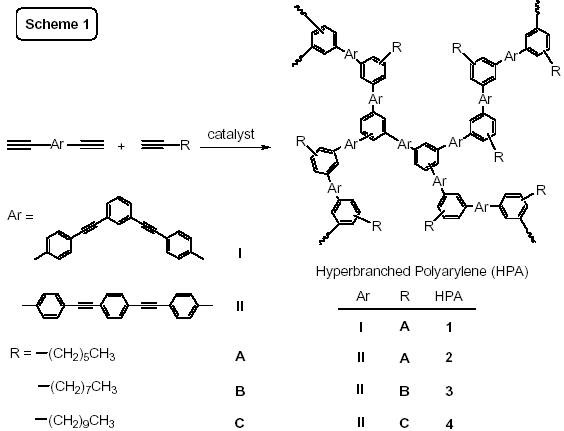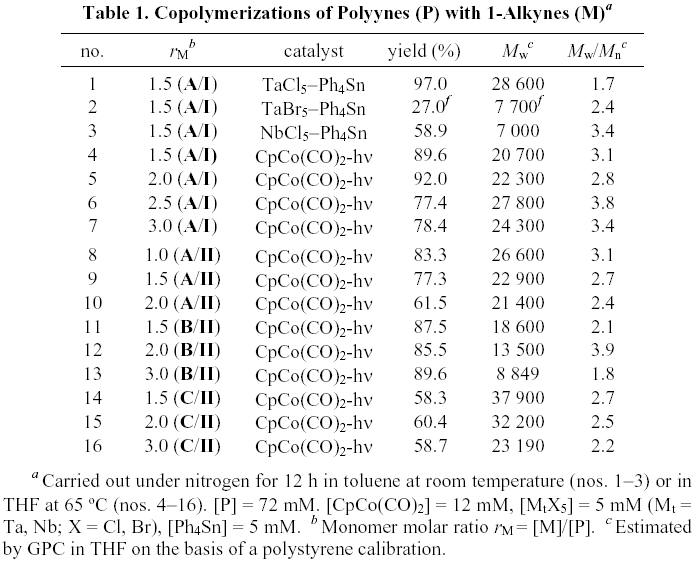Synthesis of Hyperbranched Conjugated Poly(Aryleneethynylene)S by Polycyclotrimerization
时间:2005-05-18
Han Peng,1,2 Demin Jia,1 and Ben Zhong Tang2
1 Institute of Material Science and Engineering, South China University of Technology,Guangzhou 510641, China
2 Department of Chemistry, The Hong Kong University of Science & Technology,Clear Water Bay, Kowloon, Hong Kong, China
Poly(aryleneethynylene)s (PAEs) are conjugated polymers consisting of aromatic rings and alkyne rods. The high fluorescence quantum yields and excellent stability of PAEs make the polymers a class of prospective materials for photoluminescence (PL) applications.1 Linear unsubstituted PAE is, however, infusible and insoluble.1 Different strategies have been developed to improve its processability and the most common approach is to attach linear alkyl or alkoxy side chains to the rigid-rod polymer backbone. The solubility of the polymers is, however, still a problem limiting the scope of their potential applications. We have recently designed and synthesized a series of hyperbranched polyarylenes by simple one-pot polycyclotrimerizations of aromatic diynes with monoynes.2,3 The resultant polymers show excellent PL and optical limiting properties as well as outstanding thermal stability. In this work, a series of new hyperbranched PAEs were synthesized by the polycyclotrimerizations of polyynes (I and II) with monoynes (A, B and C) catalyzed by tantalum-, niobium- and cobalt-based catalysts (Scheme 1).

The copolymerizations of I and II with 1-octyne, 1-decyne, and 1-dodecyne are effected by tantalum-, niobium-, and cobalt-based catalysts, producing hyperbranched polyarylenes 1−4 with high molecular weights (Mw up to 2.8 × 104 Da) in high isolation yields (up to 97%). The polymerization results are summarized in Table 1. The
structures and properties of the resultant polymers are characterized and evaluated by IR, UV, NMR, TGA, fluorescence, and optical limiting analyses. All the polymers give satisfactory analysis data corresponding to their expected molecular structures. Upon photoexcitation, the HPAs efficiently emit strong deep-blue light with fluorescence quantum yields up to 89%. The polymers strongly limit 8-ns pulses of 532-nm laser light, with their limiting performances being superior to that of C60, a well-known optical limiter. All the HPAs show outstanding thermal stability, with their onset decomposition temperatures up to 510 °C. The polymers graphitize when pyrolyzed at 800 °C in high yields (up to 82%). The ceramics prepared at 1000 °C under nitrogen show interesting magnetic properties. The ceramic obtained from 1-Co exhibits a low Ms of 2.98 emu/g in a magnetic field of 20 kOe at 300 K. A hysteresis loop is observed in the magnetization curve although both remanence Mr (0.73 emu/g) and coercivity Hc (0.096 kOe) are low. XPS analyses reveal that the cobalt content of the ceramics increases from surface to bulk. Observation by high-resolution electron microscopy finds that magnetic nanoparticles with a size of ~30 nm are dispersed in the amorphous graphite.

References
1. Bunz, U. H. F. Chem. Rev. 2000, 100, 1605.
2. Peng, H.; Cheng, L.; Luo, J.; Xu, K.; Sun, Q.; Dong, Y.; Salhi, F.; Lee, P. P. S.; Chen, J.; Tang, B. Z. Macromolecules, 2002, 35, 5349.
3. Peng, H.; Luo, J.; Cheng, L.; Lam, J. W. Y.; Xu, K.; Dong, Y.; Zhang, D.; Huang, Y.; Xu, Z.; Tang, B. Z. Optical Materials 2002, 21, 315.
论文来源:Asia Polymer Symposium(APOSYM/2004)October 10-16

